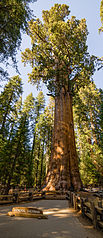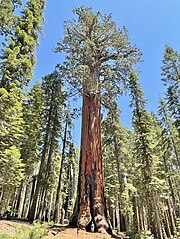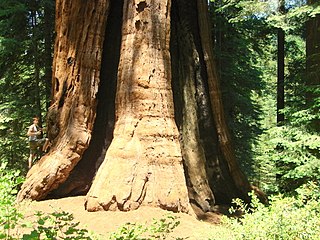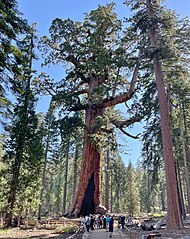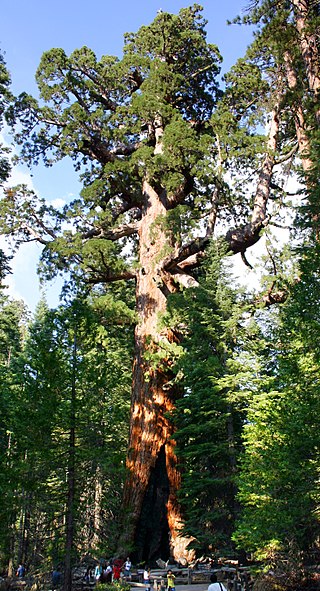
Sequoiadendron giganteum, also known as the giant sequoia, giant redwood or Sierra redwood is a coniferous tree, classified in the family Cupressaceae in the subfamily Sequoioideae. Giant sequoia specimens are the most massive trees on Earth. They occur naturally only in groves on the western slopes of the Sierra Nevada mountain range of California.

General Sherman is a giant sequoia tree located at an elevation of 2,109 m (6,919 ft) above sea level in the Giant Forest of Sequoia National Park in Tulare County, in the U.S. state of California. By volume, it is the largest known living single-stem tree on Earth.

The General Grant tree is the largest giant sequoia in the General Grant Grove section of Kings Canyon National Park in California, and the second largest giant sequoia tree in the world after the General Sherman tree. Once thought to be well over 2,000 years old, recent estimates suggest the General Grant tree is closer to 1,650 years old. The tree also features the third largest footprint of any living giant sequoia, measuring 107.6 ft (32.8 m) in circumference at ground level.

The Giant Sequoia National Monument is a 328,000-acre (512 sq mi) U.S. National Monument located in the southern Sierra Nevada in eastern central California. It is administered by the U.S. Forest Service as part of the Sequoia National Forest and includes 38 of the 39 Giant Sequoia groves that are located in the Sequoia National Forest, about half of the sequoia groves currently in existence, including one of the ten largest Giant Sequoias, the Boole Tree, which is 269 feet (82 m) high with a base circumference of 112 feet (34 m). The forest covers 824 square miles (2,130 km2).

Nelder Grove, located in the western Sierra Nevada within the Sierra National Forest in Madera County, California, is a Giant sequoia grove that was formerly known as Fresno Grove. The grove is a 1,540-acre (6.2 km2) tract containing 54 mature Giant Sequoia trees, the largest concentration of giant sequoias in the Sierra National Forest. The grove also contains several historical points of interest, including pioneer cabins and giant sequoia stumps left by 19th century loggers.
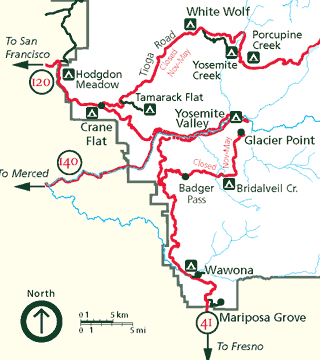
Mariposa Grove is a sequoia grove located near Wawona, California, United States, in the southernmost part of Yosemite National Park. It is the largest grove of giant sequoias in the park, with several hundred mature examples of the tree. Two of its trees are among the 30 largest giant sequoias in the world. The grove closed on July 6, 2015, for a restoration project and reopened on June 15, 2018.

The Washington tree is a giant sequoia in the Giant Forest Grove in Tulare County, California, within Sequoia National Park. It is named after George Washington, first President of the United States. Until it partially collapsed in January 2005, the Washington tree was the second largest tree in the world. Though badly damaged, the tree is still living.

Sequoia National Forest is located in the southern Sierra Nevada mountains of California. The U.S. National Forest is named for the majestic Giant Sequoia trees which populate 38 distinct groves within the boundaries of the forest.
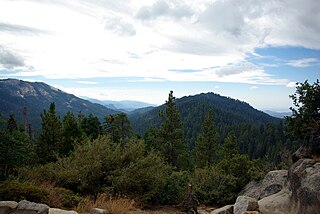
Redwood Mountain Grove is the largest grove of giant sequoia trees on earth. It is located in Kings Canyon National Park and Giant Sequoia National Monument on the western slope of California's Sierra Nevada. The grove contains the world's tallest giant sequoia. The Hart Tree and Roosevelt Tree grow in the grove and are two of the 25 largest trees by volume in the world. The largest tree is the General Sherman Tree in the Giant Forest grove to the southeast.

The Giant Forest, famed for its giant sequoia trees, is within the United States' Sequoia National Park. This montane forest, situated at over 6,000 ft (1,800 m) above mean sea level in the western Sierra Nevada of California, covers an area of 1,880 acres (7.6 km2). The Giant Forest is the most accessible of all giant sequoia groves, as it has over 40 mi (64 km) of hiking trails.

Converse Basin Grove is a grove of giant sequoia trees in the Giant Sequoia National Monument in the Sierra Nevada, in Fresno County, California, 5 miles (8 km) north of General Grant Grove, just outside Kings Canyon National Park. Once home to the second-largest population of giant sequoias in the world, covering 4,600 acres (19 km2) acres, the grove was extensively logged by the Sanger Lumber Company at the turn of the 20th century. The clearcutting of 8,000 giant sequoias, many of which were over 2,000 years old, resulted in the destruction of the old-growth forest ecosystem.

Garfield Grove is a Giant Sequoia grove. The entire 2,902 acres (11.74 km2) lies in Sequoia National Park in the Sierra Nevada range in eastern California in the United States.

Franklin is a giant sequoia in Giant Forest, a sequoia grove where the largest tree in the world lives - the General Sherman. The Franklin tree is the eighth largest giant sequoia in the world. It was named by Wendell Flint after Benjamin Franklin. Nearby trees include the Washington Tree which was once the second largest tree in the world, but since it lost half its trunk in 2005 many sequoias are now larger.
Ishi Giant is a giant sequoia in California, United States. It is located in Kennedy Grove, which is part of a group of eight closely spaced giant sequoia groves situated in Sequoia National Forest in the Sierra Nevada in eastern central California. It was the 14th largest giant sequoia in the world before it atrophied during the Rough Fire in 2015.

The Hart Tree is a Giant sequoia tree within the Redwood Mountain Grove, in the Sierra Nevada and Fresno County, California. The Redwood Mountain Grove is protected within Kings Canyon National Park and the Giant Sequoia National Monument. It is the 25th largest giant sequoia in the world, and could be considered the 24th largest depending on how badly Ishi Giant atrophied during the Rough Fire in 2015.
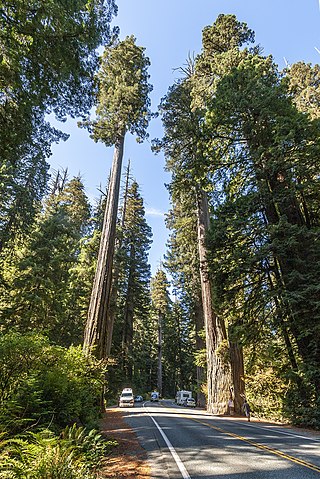
Sequoia sempervirens is the sole living species of the genus Sequoia in the cypress family Cupressaceae. Common names include coast redwood, coastal redwood and California redwood. It is an evergreen, long-lived, monoecious tree living 1,200–2,200 years or more. This species includes the tallest living trees on Earth, reaching up to 115.9 m (380.1 ft) in height and up to 8.9 m (29 ft) in diameter at breast height. These trees are also among the longest-living organisms on Earth. Before commercial logging and clearing began by the 1850s, this massive tree occurred naturally in an estimated 810,000 ha along much of coastal California and the southwestern corner of coastal Oregon within the United States.

The General Noble Tree was a monumental giant sequoia situated in the Converse Basin Grove, within the boundaries of the Giant Sequoia National Monument, in Fresno County, California. It was believed to be the biggest tree in the world before its felling in 1892 for an exhibit at the World's Columbian Exposition in Chicago. It was the largest tree ever felled.

The Methuselah Tree is a giant sequoia located in Mountain Home State Forest, a sequoia grove located in Sequoia National Forest in the Sierra Nevada in eastern California. It is the 28th largest giant sequoia in the world, and could be considered the 27th largest depending on how badly Ishi Giant atrophied during the Rough Fire in 2015.
Black Mountain Grove is a giant sequoia grove containing more than 150 relatively young trees located in a ravine on the southwestern slope of Black Mountain, a minor peak of the San Jacinto Mountains in Riverside County, California.




